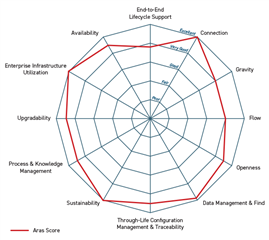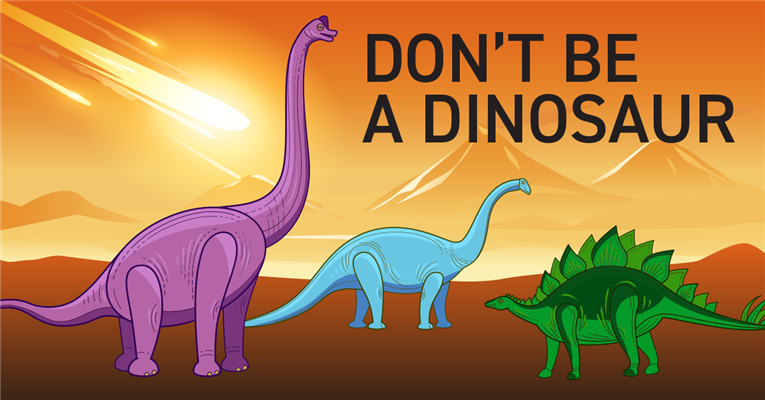Last week, I read an interesting article on Engineering.com by Verdi Ogewell entitled, Telecom Giant Ericsson Halts Its PLM Project with Dassault’s 3DEXPERIENCE.
It reminded me of a quote from science fiction author, Larry Niven: “The dinosaurs became extinct because they didn’t have a space program.” In other words, prepare to adapt or suffer the consequences.
The article covers many great points. A few in particular, piqued my interest:
Off With Their Heads
Verdi starts with a quote— “The revolution devours its own children”—from Georges Jacques Danton, an early French Revolution leader, just before he was sent to the guillotine in 1794 by the same revolutionary tribunal he helped form. Verdi is referring to those at Ericsson who lost their jobs over a planned 14-month big bang PLM deployment that was halted after three years. What strikes me is that this is by no means the worst PLM deployment out there, at least in terms of the time involved.
I commend Verdi on his excellent investigative reporting, and anyone that follows him knows he has much more to his credit. But I would point out there are many more deserving CEOs and CIOs slowly killing their companies with bad deployments and not losing their heads. It’s interesting to me that, according to the article, Ericsson is going back to evaluate what went wrong and what their options are for fixing the problem. While this seems perfectly logical, the reaction I’ve typically seen is not to declare failure, but to keep throwing good money after bad, then perform the old ostrich maneuver of sticking your head in the sand to avoid reality. Actually, if this were true, the ostrich would suffocate, so that’s a myth. My advice is to keep your head up, and don’t lose it. Invest in what works.
The Ugly Migration
As best as Verdi could determine, Ericsson’s data migration became a nightmare. “The end result is a difficult-to-read mess,” which caused the system to be become “sluggish, inefficient and, in large parts, it does not work at all when items start pointing/linking in the wrong direction.”
Not exactly sure what is going on there, but they have 400-500 downstream systems and need to revert to using their mainframe, so it sounds like a good old-fashioned PLM deployment to me.
Enterprise PLM and ERP migrations were my life for several years, and those are years I’d like back. But seriously, the short version of migrations is that it’s like a three-legged stool. You have legacy data (possibly in several systems), you have the to-be source data, and you have other systems where some of the attributes are owned (typically downstream systems) that will have some of the same data—except due to poor master data management practices, the data doesn’t match, and then you typically have duplicate parts. It’s never as simple as going from point A to point B, and even after it’s done, it requires building federated integrations that can scale.
If you want to get something this complicated done, you’ll need flexibility in the to-be PLM platform as it will have to work with many other existing systems. This is in addition to all the people, process, and capability considerations―all of which are important.
I would offer this advice to anyone considering stepping up from legacy: You should own all aspects of your data. Never buy an enterprise system that does not have open APIs and an open schema and never pay for that right. When you have open access to your data, integrations, upgrades, and migrations become much less costly and risky.
A Solution not Fully Developed
“Another important weak spot that doesn’t make things easier is that Ericsson chose to invest in a solution, 3DX, which was not fully developed for product development in telecom. On the contrary, one of the basic concepts in the deal was that the companies would jointly develop this piece within the framework of the 3DX platform.”
First, there is no such thing as a fully developed PLM, and never will be because every business is unique and trying to differentiate themselves by being more unique. This is coupled with the fact that change continues to accelerate unabated and does so during and after the deployment. Unless you plan to stop shipping product, the ability to customize, upgrade, and integrate with other systems across the lifecycle continues indefinitely. This is business, and in a good one, there is no end.
Per the article, it came down to joint development on a platform, so the platform and company were critical.
A good practice is to develop and keep an updated heat map of all your applications/systems with all the integrations. In green, all of the applications that have or can be configured. In red, all of the areas that need to be or have been fully developed. And in yellow, those areas that just require(d) low-risk customization. Once you begin doing this, you will see it change every year. And you should because your vision should always slightly out-pace technology, but your PLM should be as close as possible to both. Additionally, I’d recommend “As-Is” and “To-Be” process maps, a plan around organization change management, the right cross-section of functional and IT team members. And let’s not forget dinner.
Choosing PLM Over Dinner
Verdi describes that the Dassault vision and roadmap played an important role in Ericsson’s decision. But there were other less technical reasons: "It didn't hurt either that our chairman of the board (it was Leif Johansson at this time) knows Bernard Charles well and that they have eaten several dinners together.”
I know this begs the question: does your next PLM go better with red or white wine?
I’m thinking if this is how you’re going to decide, go with something a lot stronger.
I might be out on a limb here, but when choosing an enterprise PLM solution, I’d keep my chairman at home and send the PLM team to dinner. It will be a lot less expensive. And if anyone asks how you like your PLM, answer “well done.” Sorry.
Double Vision and who Picks up the Tab
There is always an element of needing to partner with an enterprise software vendor to get what you need and potentially gain a competitive advantage. But to be a partner, you both need skin in the game, which, means to the company, don’t pay everything upfront in license costs. If you do, that shared vision begins to be a double vision—your vision and the software supplier’s next prospect’s vision. This is why I like the subscription model, because it forces the software company to focus on the customer.
And in the interest of transparency, the software company should display a public roadmap: Aras Roadmap.
The Dinosaur Space Program
Believing that all the PLM vendors have a sustainable platform to accomplish an ambitious industrial-grade solution is like backing the dinosaur-led space program. In case you don’t believe everything said at dinner, have the software vendor develop the application in front of you. I’d go a step further and watch the upgrade, but that’s just because I work for Aras and apparently like rubbing it in.
As an appetizer, here’s an even simpler test that I am borrowing from one company (true story): have 20 users find the same part in a couple of minutes. Too simple, right? Apparently not. And the cost to eliminate said vendors was low. You can do this over coffee.
The Big Bang
I’ve done both big bang and incremental approaches successfully. Verdi’s article does a good job articulating the pros and cons of incremental approach versus the big bang. In short, it’s less cost and higher risk for the big bang. Since I know your PLM universe needs to continue to expand so long as you’re shipping products, I’m in the incremental camp. You end up with better time to value, better total cost of ownership, and a sustainably improving product platform that will continue to yield hard benefits and make your company more competitive.
Need for a Platform, not a “buzzword”
In the end, Verdi concludes that “over time, Ericsson must invest in a ‘beyond PLM system,’ a functioning Product Innovation Platform, as defined by analysts Gartner Group and CIMdata.” He hit the nail on the head. Going back to my heat map—you’re always configuring, customizing, integrating, and upgrading. Therefore, the key is a sustainable, open, industrial platform that can integrate to other systems, develop applications, and customize applications. This is what IDC, Gartner, and CIMdata refer to as a Product Innovation Platform, described by CIMdata here.
Here is how Aras rates against that criteria according to CIMdata: CIMdata's Assessment of Aras Product Innovation Platform.

Don’t be a Dinosaur
Finally, don’t bet your future on a buzzword. Before making a huge PLM investment, take the time to make sure your PLM vendor has an actual platform. Have them show you their spider chart. And here’s the hard reality: they won’t do it, because they can’t.
Don’t be a dinosaur—be prepared for the unexpected with a truly resilient digital platform.

